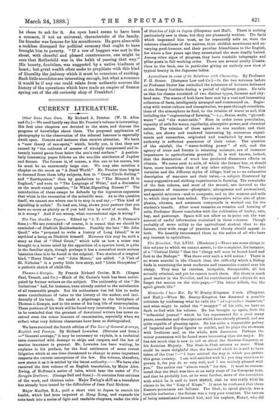Agriculture in some of its Relations with Chemistry. By Professor
F. H. Storer. (Sampson Low and Co.)—In the two volumes before us Professor Storer has embodied the substance of lectures delivered at the Bussey Institute during a period of eighteen years. He tells us that his classes consisted of two distinct types, farmers and city- bred men. The wants of both have been met by a vast and interesting collection of facts, intelligently arranged and commented on. Begin- ning with water-culture and transpiration, we pass through considera- tions of the atmosphere as food, to the relation of water to soil, this including the "engineering of farming,"—e.g., drains, wells, " ground- water " and "the water-table." Next in order come percolation, capacity of soils for water, capillarity, absorptive power, and chemical nature. The relation of these agents to one another, and their value, are shown and rendered interesting by numerous experi- ments and researches, originated and conducted by men whose authority is sufficient guarantee of their value. The question of the rainfall, the " water-bolding power" of soil, and the agency of trees and forests in retaining moisture, are of immense importance to agriculturists generally. It is well known, indeed, that the destruction of wood has produced disastrous effects on climate. We come next to soils, of which the farmer has, or should have, more knowledge than of any other subject. These, in their varieties and the different styles of tillage, lead on to an exhaustive description of manures and their value,—a subject illustrated by many suggestive and striking experiments in farming. The remainder of the first volume, and most of the second, are devoted to the preparation of manures—phosphatic, nitrogenous and ammoniacal, and special mixtures—and to composts, and to the seasons and soils to which they are best suited. The comparative value also of phos- phates, nitrates, and ammonia compounds is worked out for the student's benefit. After some remarks on rotation and burning of soils, Professor Storer concludes with the cultivation of barley, oats, hay, and pasturage. Space will not allow us to point out the vast amount of useful information contained in these volumes. Though probably of more utility to the agricultural student than to the farmer, their wide range of practice and theory should appeal to both. We heartily recommend them to the notice of all who have any interest in agriculture.


































 Previous page
Previous page